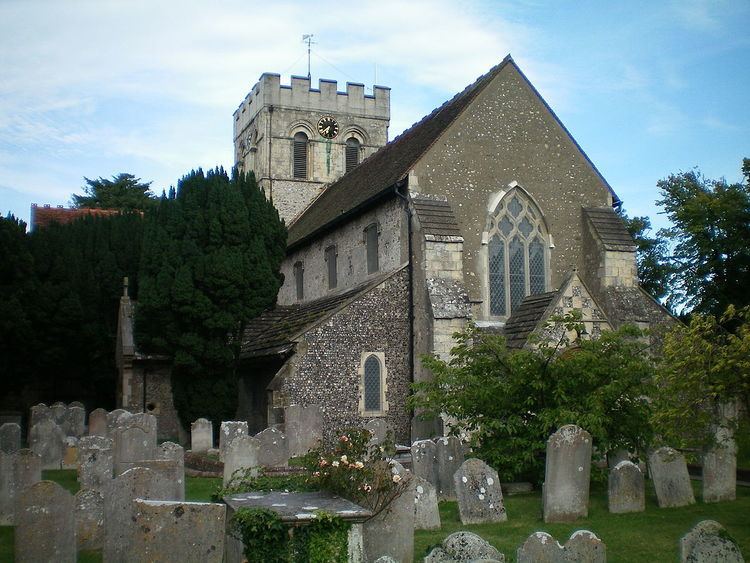Phone +44 1903 823916 | ||
 | ||
Similar Christ Church - Worthing, St Andrew's Church, St Mary of the Angels - Worthing, St Mary's Church - Goring‑by‑Sea, St Symphorian's Church | ||
St. Mary's Church, Broadwater, is a Church of England parish church in the Worthing Deanery of the Diocese of Chichester. It serves the ecclesiastical parish of Broadwater in Worthing, West Sussex. St Mary's is one of four churches in this benefice along with Hosanna, Queen Street Fellowship and St. Stephen's Church.
Contents
History
1086. The Domesday Book: "Bradwatre ... here is a church".
Not much of Saxon church remains, but it is said that repair work in 1939 uncovered a Saxon doorway in the south wall of the chancel, visible near the boiler house, and other Saxon doorjambs and window arches are preserved within the walls of the present tower.
A small Norman church was built, of which only the tower remains as shown by its arches. The clay subsoil has required successive repair and reinforcement of this tower. Legend has it that a Norman tunnel leads from the church to the nearby Broadwater Manor School (previously Broadwater Manor House). The tunnel may have been used as either an escape or smuggling route. Efforts to find the concealed entrance both from the church and the School in the 1980s were in vain.
12th century, late. Transepts added. Chancel lengthened.
12th century. A canonical sundial on the east wall.
13th century. New aisled nave built. Chancel rebuilt. Tower heightened.
14th (15th?) century. North door into the nave (main entrance, facing the village) renewed and porch added.
15th century. Windows and pillars in aisled nave altered. Low chancel screen installed, with evidence that there was at some time another screen above it.
1599. Altar slabs were removed by order of Queen Elizabeth I. The remains of a Medieval one of Sussex Marble, partially concreted over, can be seen just inside the chancel, by the screen.
1819. Gallery built at west end.
1826. Short shingled spire taken down from tower. Six chapels, three to the east of each of the transepts, were knocked down. The north transept was converted for use as a school, with a gallery. Box pews installed in the nave. Galleries were built over both aisles.
1830. The tower was embattled and a turret was added over the spiral stone staircase in its southwest corner.
1853-55. Chancel roof replaced, walls straightened ("Mr Hide's experiment") and underpinned after having begun to be pushed outwards. Chancel windows replaced, except the one in the southwest corner which still dates from 15th century. Churchyard closed, no further burials. This renovation was partially funded by Ann Thwaytes while she was living at Charmandean, Broadwater between 1841 and 1866. Some materials from the church, including a window, were taken to decorate Charmandean.
1860s. Galleries over the aisles, west end and north transept were removed. New nave pews replaced box pews. Caen stone pulpit erected, designed by Charles Hide, son of the architect in charge of this restoration. The previous Jacobean pulpit was moved to Holy Trinity church, Worthing. Clergy vestry built east of the south transept.
1866. The tower was strengthened by filling the spiral stone staircase in its southwest corner and removing the turret above it. A new wooden staircase to the tower had been put in the north transept.
1887. West end rebuilt, reopened with porch. Door in south aisle blocked up.
1903. Clock placed in tower commemorating Reverend E K Elliot's 50 years as Rector.
1938. Six 1712 bells were recast and two tenor bells added.
1953. Cox & Barnard of Hove installed a stained glass window in the south wall of the chancel. It shows John Wycliffe with a group of preachers.
1986. Wooden dais/platform built under the west arch of the tower.
1989. Tower battlements renewed.
2001. First of four phases of a reordering process to equip the church for the 21st century. New heating & lighting system.
2007. North transept re-ordered with a mezzanine floor, creating two additional rooms available for children's rooms.
2009. All pews removed from the nave and some from the chancel. Nave floor replaced with stone and underfloor heating. Inner west door replaced with glazed doors.
2013? Extending the building to provide additional facilities.
Monuments
The most notable church monument is that of Thomas West, 8th Baron De La Warr on the north wall of the chancel. He was entombed in the church in 1524 and the tomb was found under the nave floor in 2009. His son, also Thomas, died in 1554 and has a Caen stone monument at the east side of the south transept, moved from the east end of the south aisle in 1826.
John Mapulton (also known as John Mapilton), rector of the church between 1424 and 1431 was clerk to the Court of Chancery and was chancellor to Queen Joanna, widow of Henry IV. The church has a brass dedicated to John Mapilton.
Two well-preserved brasses on a stone slab were found under old pews in 1826. This was set into the centre aisle of the nave and then in 2007 moved to be positioned vertically in the north transept. The main brass cross commemorates Reverend Richard Tooner who died in 1445. Below it is a memorial to John Corby, Rector 1393–1415.
The church also has a brass dedicated to 11 fishermen who died in 1850 while trying to save the crew of the Lalla Rookh, a ship caught in a storm off Worthing.
Surgeon John White is buried in the churchyard.
Rectors of St. Mary's
A notable curate of the church was George Baillie Duncan.
